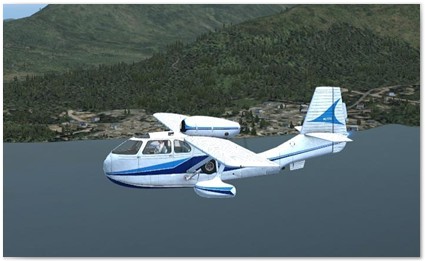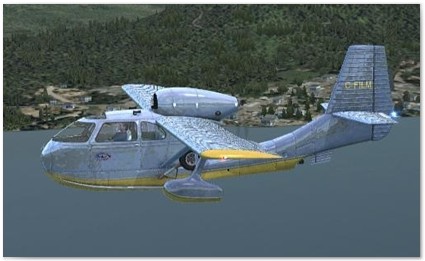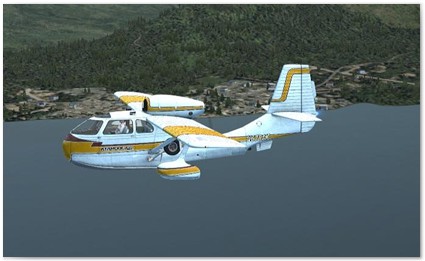Ever since I first saw a Seabee at a local
airshow a few years back I’ve wanted to have a good sim-model of
it, but had failed to find one. There was just something about the
model that really appealed to me, but I’m not quite sure what,
because let’s face it’s not a good looking airplane. Although
judging by the huge amount of information on the real life Seabee
found online I’m apparently not the only one fascinated by the
model.
With this in mind I naturally jumped at the chance to do a review
when I heard about the release of KC Flight Shops rendition of the
Seabee.
Brief History
The Republic RC-3 Seabee was the brain-child of designer Percival
Hopkins "Spence" Spencer. The origin was his S-12 Air Car
Amphibian, a fabric covered wooden construction, and in late 1943
Republic purchased the production rights for the model and started
development of an all-metal version dubbed the RC-1 Thunderbolt
Amphibian. Several modifications were made to this model in order
to simplify and streamline the production and when the prototype
RC-3 (NX87451) came off the production line in November 1945 the
Seabee was born.
In March 1946 the first production unit was finished, and in the
next 19 months the Republic factories managed to build and deliver
close to 1,060 units before announcing the decision to discontinue
the Seabee in order to utilise their production capacity for other
models.
 Livery 1 |
 Livery 2 |
 Livery - Full Metal |
 Livery - James Bond |
 Livery - Kenmore Air |
 Livery - Starburst |
Download and Installation
At the time of writing the KCFS Seabee is only available as a download from the KC Flight Shop website. The file is 172 mb in size, which should be a fairly quick download process. Payment and installation is done using the well known and hassle free Flight1 wrapper.
The installation contains 7 liveries in HD-resolution, an owner’s manual, a scanned original checklist and a parts catalog (!). In addition to this there’s also a paint-kit available as a separate download from the same source.
Documentation
As mentioned in the previous section the model comes with three PDF-files serving as documentation, but in all honesty they are more of novelty value than anything else. The rather sizable parts catalog really serves no value as documentation in the simulator at all, and the owner’s manual is really of fairly little use to a simulator user too. Most of the content is details on the maintenance of the airplane as opposed to how to fly it. Judging by the general feel and look of the owner’s manual it’s fairly likely that this is a close replica of what someone lucky enough to have bought the real plane would have been presented with as documentation.
Fear not though, first of all the Seabee is a plane that is very simple to get to grips with. If you can handle the default planes in FSX you will have no problem getting the Seabee in to the air. Secondly, all documentation you need is available in the FSX kneepad.
The checklist (both the PDF-version and the kneepad) gives you a good guideline for getting your Seabee up and running, but I to think that the kneepad version could have included a few pointers on items that aren’t modeled. I spent a fair amount of time looking for the Emergency Fuel Cutoff and the Tail Wheel Lock. After some extensive searching using the blueprints in the owner’s manual I managed to locate the Emergency Fuel Cutoff handle below the pilot seat, only to find it isn’t possible to interact with it, and I still haven’t managed to find the control for locking/unlocking the tail wheel.

|

|

|

|

|

|
External Model
The external model is very nicely done, with most of the external animations you can expect. The only thing I sort of miss is the animation of the variable pitch of the propeller. But on the other hand, this is a small detail that’s only visible before you start your engine so it’s not a very big deal that it’s missing. What you do see matches up very closely with what I’ve seen of the real model.
A nice touch is that if you apply the parking brake while parked in the water an anchor will be deployed, but a fair warning is in order though as it will not hold you in place. In the initial release this feature had a few issues with wheel chocks showing in the water, and huge amount of water splashing over the front of the aircraft. This has now been amended in the service pack released in April.
The liveries supplied are stunning in detail, and in contrast to many other models the liveries aren’t done to look like a brand spanking new airplane, but one that’s got more than a few hours on the clock. There’s plenty of wear and tear present and grime and dirt are accumulated where you would expect to find it. There’s also plenty of evidence on the bow that suggest that the plane has been in the water for quite some time.

|

|

|

|

|

|
Virtual Cookpit
The attention to details carries through to the Virtual Cockpit, and the signs of wear and tear are present on the dash board too. Both modeling and textures are of high quality, and there’s really not much to complain about in “the office”. From what I’ve found in different online sources what you get in the VC is a faithful recreation of what was in the original plane, although if you did see one today it’s more than likely that the avionics has been modernised during the years.
With the released service pack there’s even a female passenger in the right seat, but the way she keeps rubbing her stomach I can’t help to wonder if there’s another passenger hidden in there!
However, the first thing that did strike me when I got behind the controls was the very sparse instrumentation on the main panel. There is an altimeter, a speed indicator, a compass and some read-outs from the engine. The lack of an artificial horizon and VSI makes it very clear that this is a VFR-only plane.
There is a COM radio too, and even a NAV radio but I can’t really figure out why the latter is there since there’s no instrumentation to help you navigate towards the tuned VOR/DME. But it does give you a chance to practice your morse code.

|

|

|

|

|
|
Flying the Seabee
Before you get the chance to experience the Seabee in the air you will need to wrestle it down the taxiway and runway. To taxi you need to be very gentle with both the power and your rudder pedals ( I should at this point confess that I never managed to master the art of taxiing a taildragger, but I did find the Seabee to be harder to handle on the ground than other planes in my hangar).
If you do find yourself in a tight spot, or indeed in a parking spot that’s hard to get out of, there’s also a nice feature in the shape of a “reverse gear” in the overhead panel.
Once you’ve found your way to the runway and you start your take-off run you will find a very strong inclination for the plane to yaw to the left. If you do take of at full throttle it will almost take a full deflection of the rudder to keep the plane in a straight line.
Handling in water is much like on ground, but the yaw effect isn’t as distinct as it is on the ground and taxiing is a tad easier.
Once airborne everything calms down and the Seabee is a joy to fly. She trims out easily and is as stable in the air as you can expect from an airplane of its size. The only slight issue you will need to keep an eye on is a tendency to roll left on full power, other than that the Seabee will get you to your destination as long as you keep away from clouds and fog. Granted it will not get you there in a hurry (you might even get there faster in a car) but eventually you’ll get there.
Stop Press
Just at the time of going to press, KC Flightshop made this announcement which is great news for FSX and Prepar3D users alike:
"KCFS is very happy to announce the release of V2 of its Republic Seabee add-on for FSX. The new version bring a few small fixes such as corrections to the speedo, fixes to the pilots manual, and many other small fixes and changes, all to improve the Seabee. One big change is the support for Lockheed Martin’s Prepar3d (P3D)! If you have P3D and wish to install the Seabee, please use the specific P3D installer listed in the products page.
If you have already purchased the FSX version of the KCFS Republic Seabee, your license will work for the P3D version just fine. Also, you can have both the FSX and P3D Seabee installed on the same system with the same license. No need to buy a new license! Just download the correct installer for your flight sim, and enjoy!"
![]()
Verdict
![]()
I have really enjoyed the time spent
reviewing the Seabee. The modeling and liveries are among the
best I’ve seen in a GA aircraft. It’s clear that this is a
product made by a Seabee enthusiast, and other Seabee
enthusiasts won’t be missing much in the experience, even though
there are a few things I feel is missing in the documentation
department.
All in all I can wholeheartedly recommend this product to anyone
who wants a Seabee to fly, but can’t afford to get the real one.
The same is true for anyone that is after a visually stunning
GA-plane without IFR capabilities.
I award the KC flightshop rendition of the Republic Seabee a
strong Mutley's Hangar score of 8.5 out of 10.
![]()
Mikael Stockfors
Review machine Spec:Intel Core i7 860 @
2.8GGhz | 16 gb DDR III Ram @ 1600 mhz |
GTX 560 TI OC 1GB Graphics |Windows 7 64bit Pro
